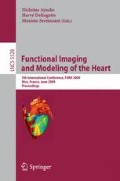Abstract
Automatic delineation of the myocardium in real-time 3D echocardiography may be used to aid the diagnosis of heart problems such as ischaemia, by enabling quantification of wall thickening and wall motion abnormalities. Distinguishing between myocardial and non-myocardial tissue is, however, difficult due to low signal-to-noise ratio as well as the efficiency constraints imposed on any algorithmic solution by the large size of the data under consideration. In this paper, we take a machine learning approach treating this problem as a two-class 3D patch classification task. We demonstrate that solving such task using random forests, which are the discriminative classifiers developed recently in the machine learning community, allows to obtain accurate delineations in a matter of seconds (on a CPU) or even in real-time (on a GPU) for the entire 3D volume.
Access this chapter
Tax calculation will be finalised at checkout
Purchases are for personal use only
Preview
Unable to display preview. Download preview PDF.
References
Lynch, M., Ghita, O., Whelan, P.: Left-ventricle myocardium segmentation using a coupled level-set with a priori knowledge. Computerized Medical Imaging and Graphics 30(4), 255–262 (2006)
Amit, Y., Geman, D.: Shape quantization and recognition with randomized trees. Neural Computation 9(7), 1545–1588 (1997)
Breiman, L.: Random forests. Machine Learning 45(1), 5–32 (2001)
Winn, J.M., Shotton, J.: The layout consistent random field for recognizing and segmenting partially occluded objects. In: CVPR (1), pp. 37–44 (2006)
Shotton, J., Johnson, M., Cipolla, R.: Semantic texton forests for image categorization and segmentation. In: CVPR (2008)
Schroff, F., Criminisi, A., Zisserman, A.: Object class segmentation using random forests. In: BMVC (2008)
Sharp, T.: Implementing decision trees and forests on a GPU. In: Forsyth, D., Torr, P., Zisserman, A. (eds.) ECCV 2008, Part IV. LNCS, vol. 5305, pp. 595–608. Springer, Heidelberg (2008)
Caruana, R., Niculescu-Mizil, A.: An empirical comparison of supervised learning algorithms. In: ICML, pp. 161–168 (2006)
Noble, J., Boukerroui, D.: Ultrasound image segmentation: a survey. IEEE Trans. Med. Imaging 25(8), 987–1010 (2006)
Yan, J., Zhuang, T.: Applying improved fast marching method to endocardial boundary detection in echocardiographic images. Pattern Recognition Letters 24(15), 2777–2784 (2003)
Angelini, E.D., Homma, S., Pearson, G., Holmes, J.W., Laine, A.F.: Segmentation of real-time three-dimensional ultrasound for quantification of ventricular function: A clinical study on right and left ventricles. Ultrasound in Medicine & Biology 31(9), 1143–1158 (2005)
Jacob, G., Noble, J., Behrenbruch, C., Kelion, A., Banning, A.: A shape-space-based approach to tracking myocardial borders and quantifying regional left-ventricular function applied in echocardiography. IEEE Trans. Med. Imaging 21(3), 226–238 (2002)
Zhu, Y., Papademetris, X., Sinusas, A., Duncan, J.S.: Segmentation of myocardial volumes from real-time 3D echocardiography using an incompressibility constraint. In: Ayache, N., Ourselin, S., Maeder, A. (eds.) MICCAI 2007, Part I. LNCS, vol. 4791, pp. 44–51. Springer, Heidelberg (2007)
Nillesen, M.M., Lopata, R.G., Gerrits, I.H., Kapusta, L., Thijssen, J.M., de Korte, C.L.: Modeling envelope statistics of blood and myocardium for segmentation of echocardiographic images. Ultrasound in Medicine & Biology 34(4), 674–680 (2008)
Tao, Z., Tagare, H., Beaty, J.: Evaluation of four probability distribution models for speckle in clinical cardiac ultrasound images. IEEE Trans. Med. Imaging 25(11), 1483–1491 (2006)
Chang, R., Wu, W., Moon, W.K., Chou, Y., Chen, D.: Support vector machines for diagnosis of breast tumors on US images. Academic Radiology 10(2), 189–197 (2003)
Drukker, K., Giger, M.L., Vyborny, C.J., Mendelson, E.B.: Computerized detection and classification of cancer on breast ultrasound1. Academic Radiology 11(5), 526–535 (2004)
Freund, Y., Schapire, R.E.: Experiments with a new boosting algorithm. In: ICML, pp. 148–156 (1996)
Pujol, O., Rosales, M., Radeva, P., Nofrerias-Fernández, E.: Intravascular ultrasound images vessel characterization using adaboost. In: Magnin, I.E., Montagnat, J., Clarysse, P., Nenonen, J., Katila, T. (eds.) FIMH 2003. LNCS, vol. 2674, pp. 242–251. Springer, Heidelberg (2003)
Georgescu, B., Zhou, X.S., Comaniciu, D., Gupta, A.: Database-guided segmentation of anatomical structures with complex appearance. In: CVPR (2) (2005)
Quinlan, J.R.: Induction of decision trees. Machine Learning 1(1), 81–106 (1986)
Andres, B., Köthe, U., Helmstaedter, M., Denk, W., Hamprecht, F.A.: Segmentation of SBFSEM volume data of neural tissue by hierarchical classification. In: Rigoll, G. (ed.) DAGM 2008. LNCS, vol. 5096, pp. 142–152. Springer, Heidelberg (2008)
Hope, T.A., Gregson, P.H., Linney, N.C., Schmidt, M.H., Abdolell, M.: Selecting and assessing quantitative early ultrasound texture measures for their association with cerebral palsy. IEEE Trans. Med. Imaging 27(2), 228–236 (2008)
Vibha, L., Harshavardhan, G.M., Pranaw, K., Shenoy, P.D., Venugopal, K.R., Patnaik, L.M.: Lesion detection using segmentation and classification of mammograms. In: AIAP 2007, pp. 311–316 (2007)
Viola, P.A., Jones, M.J.: Robust real-time face detection. In: ICCV, p. 747 (2001)
van Rijsbergen, C.: Information Retrieval. Butterworth (1979)
Author information
Authors and Affiliations
Editor information
Editors and Affiliations
Rights and permissions
Copyright information
© 2009 Springer-Verlag Berlin Heidelberg
About this paper
Cite this paper
Lempitsky, V., Verhoek, M., Noble, J.A., Blake, A. (2009). Random Forest Classification for Automatic Delineation of Myocardium in Real-Time 3D Echocardiography. In: Ayache, N., Delingette, H., Sermesant, M. (eds) Functional Imaging and Modeling of the Heart. FIMH 2009. Lecture Notes in Computer Science, vol 5528. Springer, Berlin, Heidelberg. https://doi.org/10.1007/978-3-642-01932-6_48
Download citation
DOI: https://doi.org/10.1007/978-3-642-01932-6_48
Publisher Name: Springer, Berlin, Heidelberg
Print ISBN: 978-3-642-01931-9
Online ISBN: 978-3-642-01932-6
eBook Packages: Computer ScienceComputer Science (R0)

